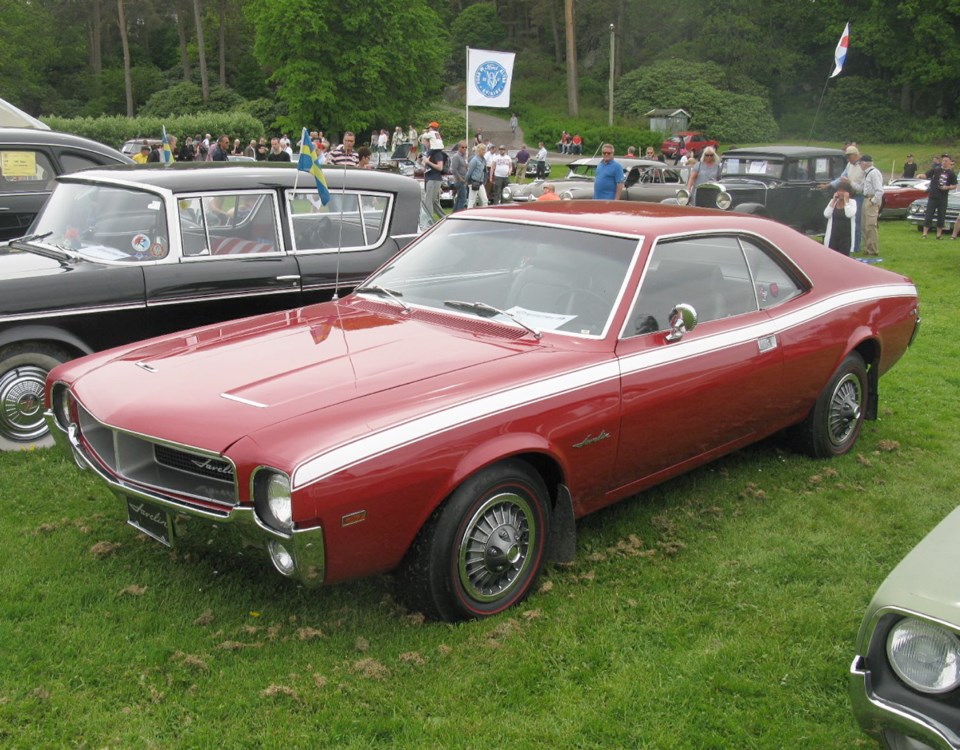The 1960s spawned two new car genres, the muscle car and the pony car. Muscle cars began with the 1964 Pontiac Tempest GTO option, a regular Tempest compact with a big V-8 engine. They provided rapid acceleration, although the handling usually left something to be desired.
The pony car was different. In spite of humble roots, it brought new, low, sporty styling along with better handling. The Ford Motor Co. launched the pony-car era with the Falcon-based Ford Mustang in mid-1964. General Motors responded with its 1967 Chevrolet Camaro.
Little American Motors Corp., still trying to go head to head with the Big Three, introduced its pony car the following year and it turned out to be a good one. The new 1968 AMC Javelin coupe replaced the late, unlamented Rambler Marlin fastback, which had lasted just two model years.
With the Javelin, AMC’s chief stylist Richard Teague vindicated himself. The styling was crisp and fresh with the long-nose, short-deck pony-car silhouette. It had a 2,769-millimetre wheelbase, compared with the Mustang’s 2,743 mm, and offered more interior room than any other pony car except the Mercury Cougar. It came in standard and upscale SST models.
Base power for AMC’s “four-passenger sporty car” was the corporate 3.8-litre (232 cu. in.) overhead-valve, 145-horsepower inline six. Those seeking brisker performance chose 4.7-litre (290 cu in.) or 5.6-litre (343 cu in.) overhead-valve V-8s.
The Javelin’s suspension was A-arms and coil springs in front and a solid axle on leaf springs at the rear. By adding such options as an anti-roll bar and stiffer shock absorbers, it could be made into a surprisingly good handler.
The Javelin V-8 was quite spirited. Car Life tested one with the 280-horsepower 5.6-litre engine and four-speed manual transmission. Although hampered by inappropriate gear ratios that caused serious wheelspin, testers still managed a pretty quick zero to 100 km/h acceleration time of 8.1 seconds.
This was very competitive with a Mustang with a 6.4-litre (390 cu in.) engine (albeit with an automatic transmission), which did a marginally better zero to 100 in 7.8 seconds. Top speed was similar at 184 km/h for the Javelin and 182 for the Mustang.
Aided by a price that was a little under the Mustang’s, the Javelin recorded a surprising 56,000-plus sales during the 1968 model year, helping pull AMC into the black for the first time since 1965 (it had lost $75.8 million in 1967). It would be the Javelin’s best year.
A companion model, the short-coupled AMX with a 2,464-mm wheelbase, appeared in mid-1968. This two-passenger version never sold in high numbers and was discontinued in 1970, although AMC carried the AMX name on the Javelin.
For 1969, the Javelin was largely unchanged except for a new grille. The corporate 6.4-litre (390 cu in.) V-8 was now an option. Despite gimmicks like the “Go” package with its fake hood scoops and the SST’s “Big Bad” stripe-and-spoiler option, Javelin’s 1969 model year sales fell to just over 40,000.
The ’70 Javelins were again mostly carry-overs, but to give it faster track times AMC introduced the Trans-AM racing version with a four-barrel carburetor and a handling package. Nonetheless, sales slipped to slightly more than 28,000 for the 1970 model year and would never again exceed 30,000.
In 1971, racing success came for the Javelin. Superbly driven by Mark Donohue, the Javelin won the Sports Car Club of America Trans-Am championship. It was, however, a somewhat hollow victory, as the other factory teams were no longer competing. AMC’s racing activities prompted a limited edition bespoilered “Mark Donohue Special” and a few Trans-Am models painted in the racers’ red, white and blue.
For 1971, Teague made the Javelin look all new when it really wasn’t. The most dramatic change was prominent front and rear fender humps. An even bigger V-8 was offered — the 6.4-litre enlarged to 6.6 litres (401 cu in.), AMC’s largest engine ever.
In spite of tighter emission controls strangling power and causing performance to suffer, the company sold 29,000 ’71 models.
For 1972, the Javelin received a new grille. Sales held at just above 26,000, a figure they would stay close to throughout the last two model years, 1973 and ’74.
The Javelin was being caught in the decline of pony cars and muscle cars as skyrocketing insurance rates, emissions legislation and the first oil crisis made life tough for performance cars. Large, thirsty V-8 engines became socially unacceptable almost overnight, and these factors (plus the fact that AMC needed production capacity for its new Pacer) finished its most exciting car.



